Balcony privacy ideas – 9 effective ways to create a private outdoor space
From climbing plants to decorative screens, there are plenty of stylish and functional ways to screen your balcony garden from view
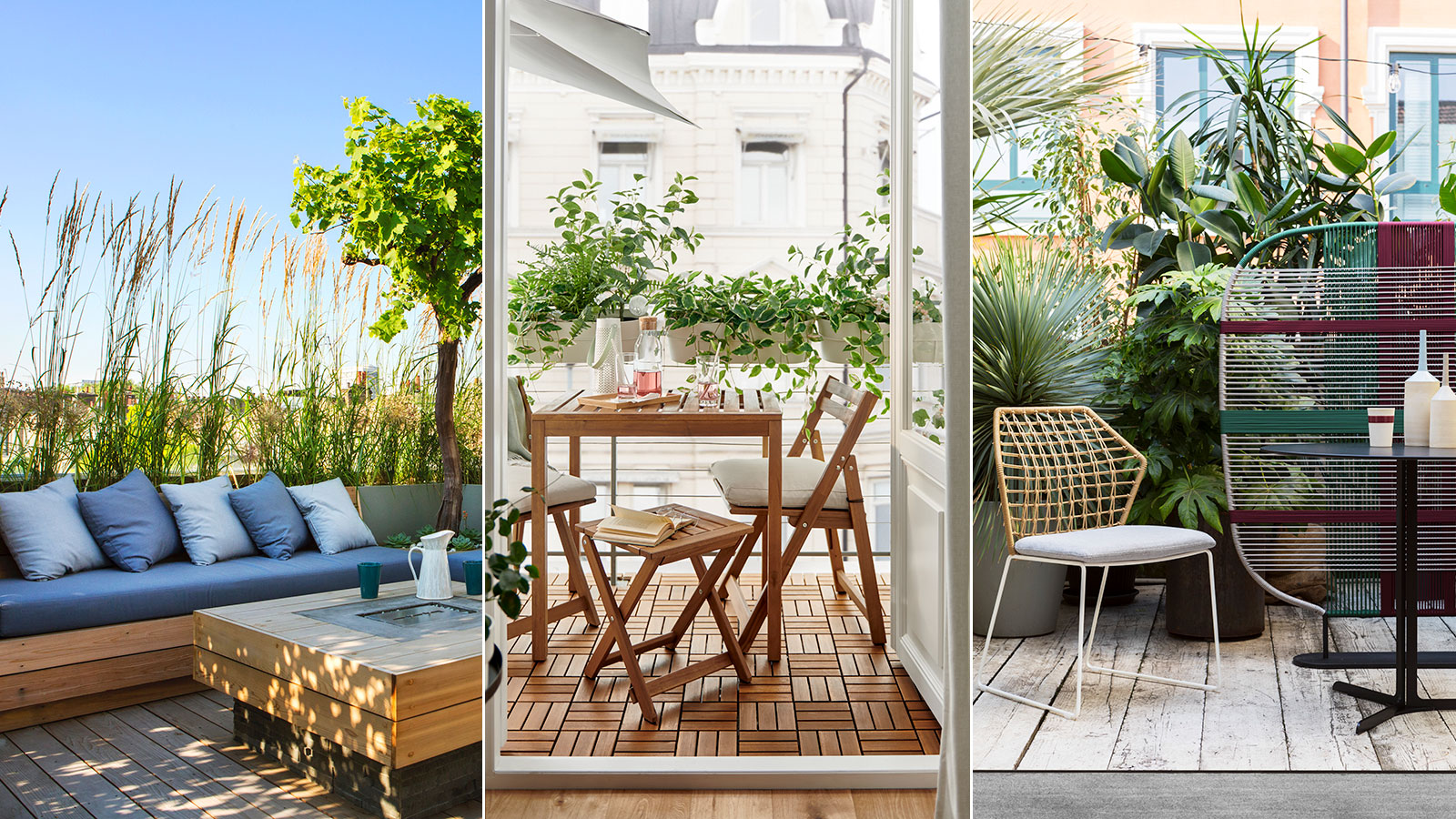

Looking for ways to create more privacy on your balcony? No problem, there are plenty of stylish solutions to explore – featuring plants, screens, super-sized containers, clever seating and more.
Sure, there are various factors to bear in mind, as the size, shape and aspect of your balcony garden will have to be considered. But with some careful thought you can create a fun and intimate spot for hosting friends, soaking up the sun or to chill and enjoy some quiet me time.
‘Your climate, building structure, elements in your surroundings, such as the direction your balcony faces, will all help influence and dictate what is going to work best for you,' says Janna Robinson, Lifestyle-Tech expert and interior designer. 'The key thing to remember whenever choosing outdoor products, is to make sure your proposed items will withstand the elements.’
10 balcony privacy ideas for a stylish, secluded space
Whether you have a small and cozy balcony or a larger outdoor space to play with, there are plenty of ways to turn it into a secluded spot away from prying eyes.
'Balconies are sometimes very overlooked and exposed to the elements, and therefore they can feel uninviting,' says Beth Murton, head of gardens for Homes & Gardens. 'While in most instances you don't want to entirely block your view from the balcony, especially if you have a particularly beautiful outlook, finding ways to introduce an element of garden screening can help to create a more useable, welcoming space to spend time.'
1. Keep it simple with a row of balcony planters
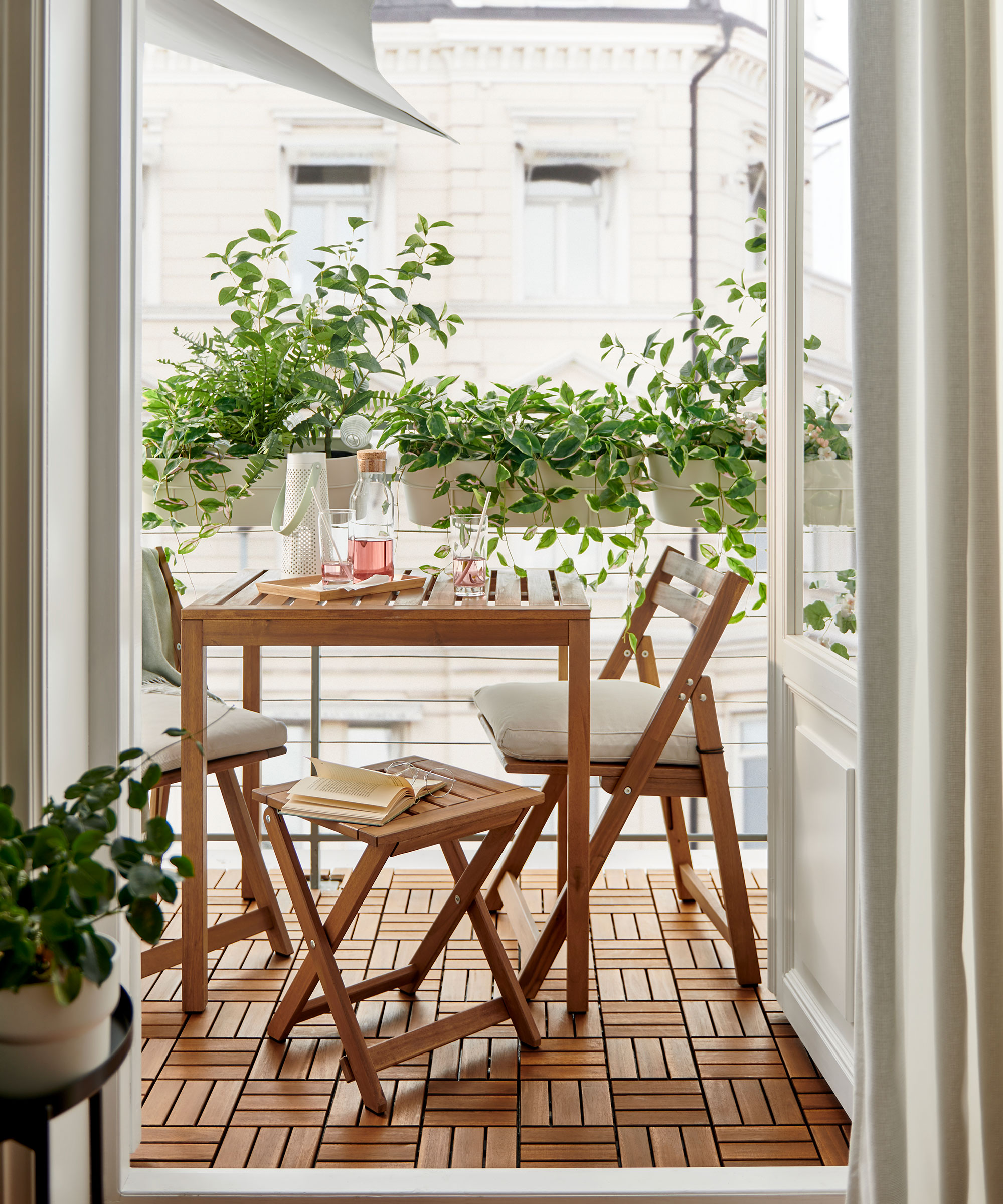
When people are sitting at the table, these planters are placed at eye level to enhance the feeling of privacy. Furniture from Ikea
Adding privacy to your balcony space doesn't have to involve a huge amount of work. Simply adding a line of outdoor planters to your balcony railings can quickly shield a small dining or seating area from view. 'Look for designs that can simply be slotted over the top of the railings – although always secure your container garden in place properly to ensure they won't get knocked or blown off in high winds or poor weather,' says Beth Murton.
‘Keep your climate and other elemental surroundings in mind when choosing your foliage, especially if you are opting for genuine instead of artificial,’ says Janna Robinson. ‘If your selection is artificial make sure you look at the quality of the material, can it be exposed to sunlight, is it water or weather resistant, what is the quoted longevity of the product when exposed to outdoor elements.
‘The reality is, artificial outdoor plants and foliage have a shelf life, so you want the highest-quality product that will give you the most longevity and biggest bang for your buck,' adds Janna. 'The most common outdoor artificial foliage is UV-resistant/treated. These products have been sprayed with the resistant chemicals which helps protect against fading and harsh or direct sunlight.'
2. Create a natural screen with large leaved plants
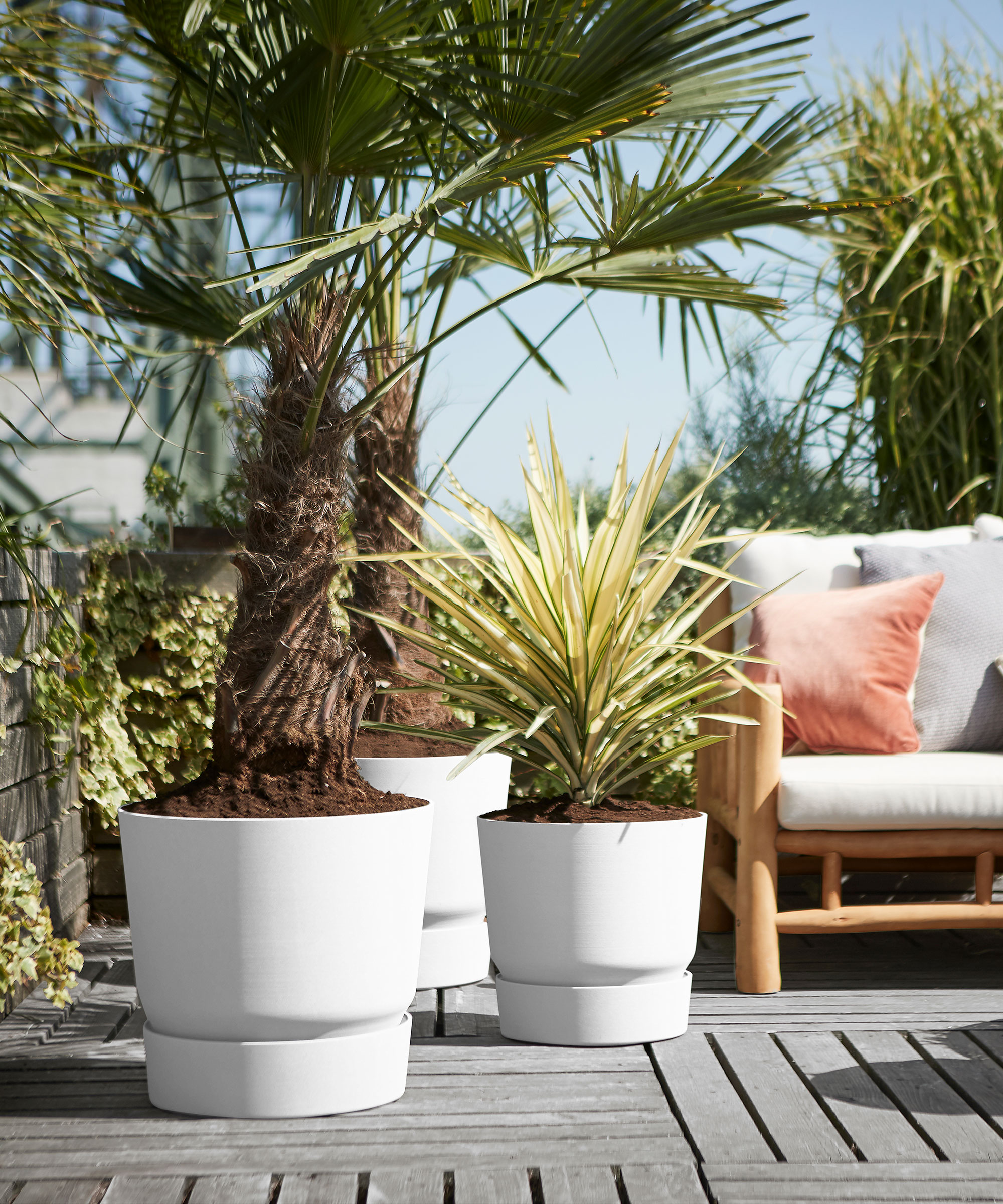
Large tropical plants in pots can make a statement as well as create privacy
‘Play with scale – don't think small, just because your space is small,' says James Dowsing-Reynolds, founder and designer at Dowsing & Reynolds. ‘Use big-leaf plants like evergreen fatsia japonica to create the jungle look, or sun-loving, silver-leafed plants like oleander, eucalyptus or lavender for a Mediterranean feel.'
Besides creating a rich tapestry of foliage and an attractive backdrop, large leaved balcony plants also form an effective barrier, offering seclusion and shade. Chusan palm, cordyline and phormium are all pretty tough and can cope with most weather conditions, but to keep it visually interesting aim for a mix of leaf shapes and textures. Feeling particularly daring? Try the patterns and colors of tender exotics such as coleus, calathea and canna.
3. Install a wooden divider

A slatted timber screen is a great backdrop for a vertical garden
A great way to introduce privacy but also let daylight filter through, a slatted timber wall is a smart way to screen your balcony from view.
A run of timber slatted panels with built-in shelving will create a sleek contemporary style barrier without dominating the space. Plus, the gaps between the battens will also let air flow through, ventilating the space, keeping plants healthy and allowing any strong breeze to pass by.
Integral shelves offer stylish storage and display opportunities, without encroaching on valuable floor space. Choose to plant up with fragrant culinary herbs, colorful annual flowers or a mass of trailing plants to create your own living wall.
4. Plant a living screen to hide a space from view
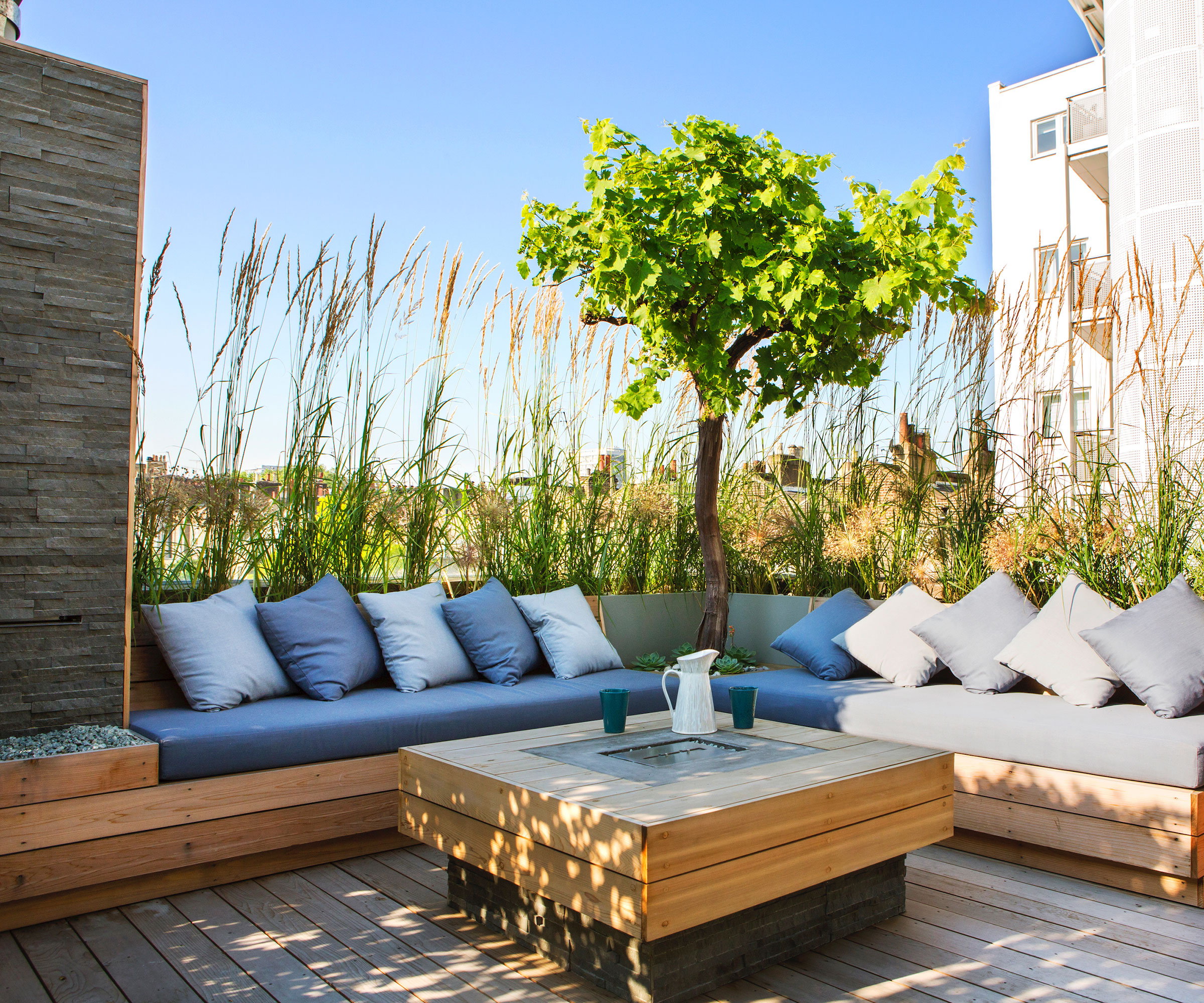
Ornamental grasses will also add a sensory element as they rustle in the breeze
Built-in balcony seating nestled in amongst tactile planting is always going to be a winning combination, but especially when a little privacy and shade is needed.
In this streamlined garden designed by Adolfo Harrison, a row of upright Calamagrostis ‘Karl Foerster’ creates a beautiful living boundary, that looks particularly graceful when swaying in the breeze. Planted in powder-coated aluminum planters that sit neatly behind the timber clad corner bench, these ornamental grasses will grow to form a tactile summer border that dies back in winter, before regrowing in spring.
Other planting options for balcony boundaries are suggested by Robert Silver, CEO of Pro Gardening Blog. ‘Plant a row of semi-evergreen or evergreen shrubs or trees to create a natural barrier. Bamboo – as a fast-growing plant – is great for creating a tall privacy screen, while ornamental grasses add height and privacy to your garden.’
5. Invest in freestanding privacy screens
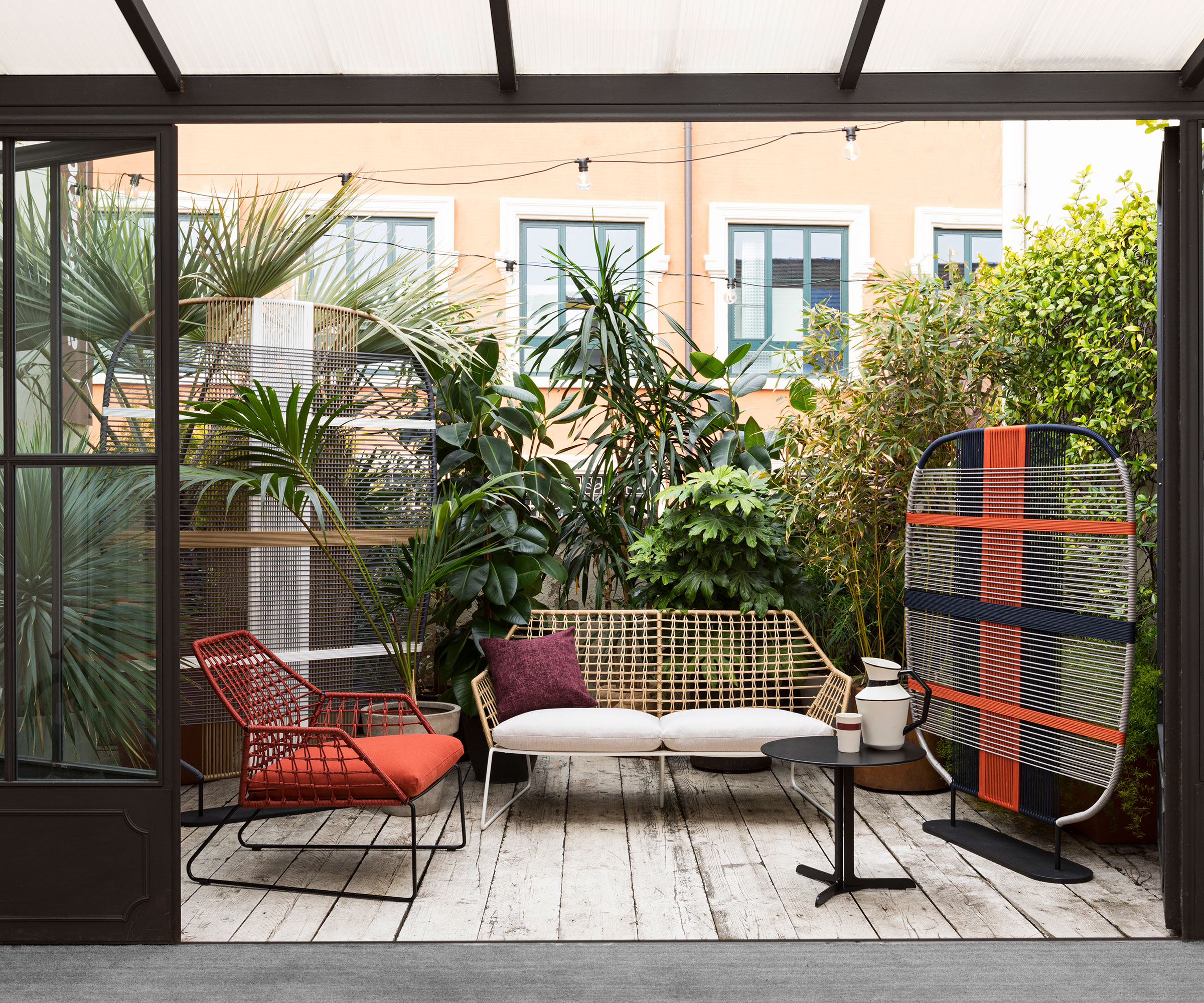
A freestanding screen gives you the option to move it around your space at different times of the day, depending on the area you want to hide from view
Garden zoning can be just as effective on a balcony space as it can in a larger backyard. It's easy to partition off a dining or lounging area of your balcony with a striking freestanding screen. Easy to move into position as and when needed, there’s no simpler option when considering balcony privacy ideas.
Screen designs vary hugely – from these bold yet chic designs woven from polyester rope and coated wire around a metal frame – to more rustic woven willow wands set in a timber panel. Overall weight of the screen – and its stability – depends not only on the materials used and the size of the screen but the footprint and size too.
From solid metal plates that sit flush on the ground, to protruding fin style feet and those with integral box planters, there are endless options, each offering their own varying degree of stability, which can be crucial if your balcony is very high up or exposed.
6. Gain privacy with climbing plants

Add scent, color, texture and privacy to a balcony with a climbing plant such as this Princess Dianna clematis from Taylors Clematis
Letting plants provide privacy in any garden is hugely satisfying, but particularly when on a balcony. Climbing plants are perfect for growing in small spaces as they take up little floor space and will happily cover railings, trellis and upright supports. The key is to choose plants that will survive in your particular environment, taking into account how exposed the site is to sun, wind and shade.
David Angelov, CEO and Founder, Master Gardener of Plant Parenthood Design says, ‘One of my favorite climbing plants is a climbing hydrangea. Their evergreen glossy leaves provide great deep color all year round and flowers are a bonus, twice a year. Sticking to any and every surface, the hydrangea will climb and is easily prunable to desired length and density. One climbing hydrangea can live in a large pot over 20in in diameter.’
Of course, there are plenty of other interesting options to consider but for speedy coverage David has another firm recommendation. ‘A clematis can also be grown in a smaller pot but only during the summer months here in Massachusetts as it doesn’t survive our zone 7b winters. They have fantastical flowers and are usually covered with them. They grow fast in one season and should be cut back to the base at the end of the year.’
7. Raise up potted plants on a table
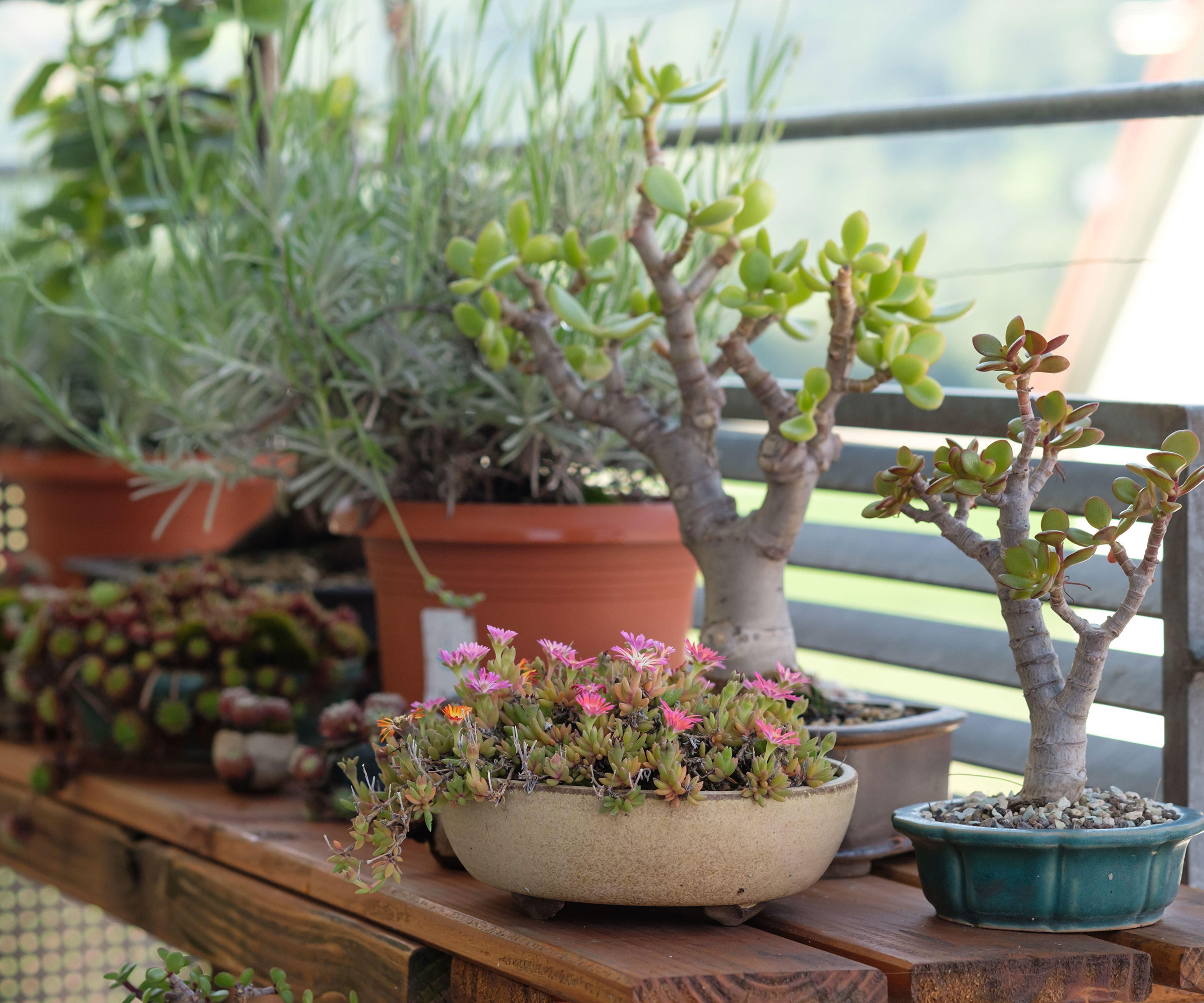
Succulents can survive in exposed spots such as on a balcony
If you only have room for small potted plants, placing them on top of a small table, potting table or outdoor garden storage can make them more effective at screening a balcony space from view.
When it comes to choosing plants for a balcony, of course it should be a matter of personal choice, but in some situations, you do need to be a little selective as only some plants can cope with harsh winds or deep shade. ‘If the balcony does not receive much direct sunlight, search for shade-loving plants. A west-facing balcony presents the greatest challenge,’ says Jean Bloom, an avid gardener for over 30 years and author of Gardening Faq’s website, ‘since these plants only receive late-afternoon sun. Frangipani and other succulents thrive in these exposed conditions.
‘Consider how windy the balcony is before deciding whether to grow a climbing plant that prefers shade on the protected side of a screen,' adds Jean. 'On a windy balcony, choose bushes with many branches and little leaves. Plants like coprosma (Coprosma 'Pacific Sunrise' or C. 'Pacific Sunset') or Indian hawthorn (Rhaphiolepis indica) can handle some shade as well.’
8. Fix up a sail shade for instant privacy
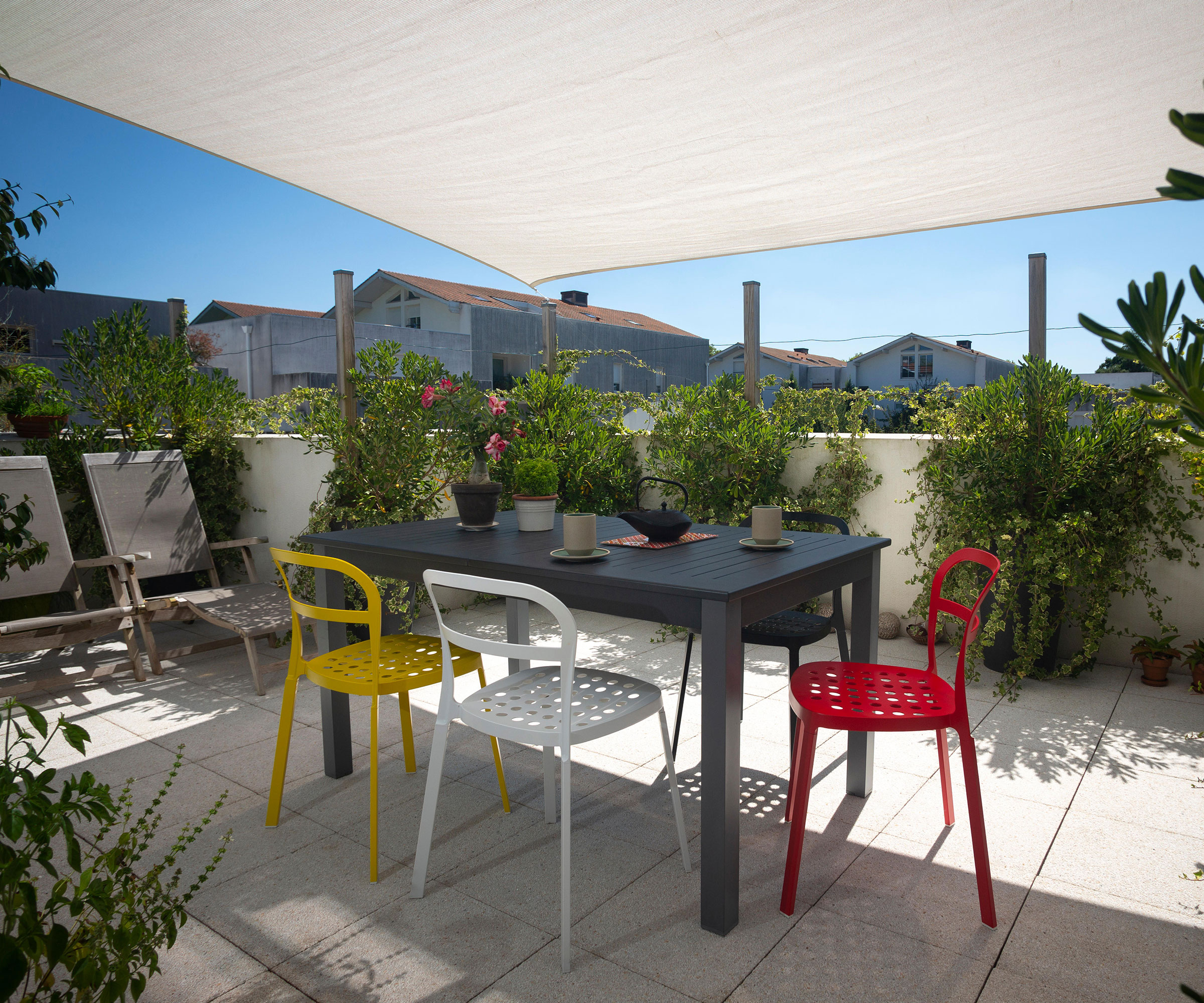
Simple, effective and relatively easy to install, a modern sail shade is a smart way to introduce privacy to a balcony dining area
Triangular, square or rectangular – sail shades are simply panels of fabric tensioned to sit taut between fixing points such as posts, buildings or poles. Popular as a backyard shade idea for patios, decks and terraces they are handy for covering balconies too, providing shade, privacy and a degree of protection from wind and rain.
There is a huge variation in, not only sail shade design, but quality and price point too when opting for these types of patio cover. The key points to look for when buying include fabric choice, construction, and fixings. Manufacturers fabric samples are useful for gauging weight and quality, plus they should come with a UV rating and life expectancy, so do request before ordering.
Stitching is another detail to check. Look for high quality PTFE (100% polytetrafluorethylene) thread which is heat and UV resistant and check that seams are double, or triple sewn.
Corners are important too, as they take most of the sail’s stress and strain. Extra stitching and webbing should be used to reinforce each of the stainless-steel attachment rings. These are then fixed to the sail supports with tension screws - also known as adjusters or turnbuckles.
9. Fit decorative fretwork screens

Instead of a glazed balcony that offers no privacy, consider a more decorative design instead
Composite garden fence panels are real winners when it comes to boosting yard style and reducing upkeep, and they look stunning around balconies too. Made from a blend of recycled wood powder and plastics, they are robust, UV stable and weatherproof and need little more than a yearly wipe down to keep them looking good. Possessing anti-bacterial and non-porous properties they also inhibit the growth of mould or algae.
With endless colored finishes, fretwork designs and panels sizes to choose from you can pair them with wooden, concrete or powder-coated aluminum posts for a sleek, contemporary result. Tailor the overall design to provide as much or little privacy as you need. Top close board panels with narrow perforated sections or go for a symmetrical layout using full-height panels in both solid and pierced composite. Many products have two contrasting sides, each with their own finish – deep woodgrain or smooth for example – so you can personalize your own installation.
Can you put a privacy screen on a balcony?
Privacy screens are a great way to keep out prying eyes, so you can relax and enjoy your space, but they do need to be safe and functional as well, particularly if your balcony is high up or in an exposed position.
Before going ahead, check with your HOA or management to ensure the product and installation complies with any rules and regulations. You will also need to talk through the project with your chosen retailer to make sure that the product you are considering is suitable for the location.
As Francesca Sgolmin, Product Specialist, from Maanta Outdoor explains, ‘To properly design a safe privacy screen, you'll need to ascertain the location of the job and the wind speed of that area, the altitude of the site, the height of the building or structure as well as the distance the site is from the sea. You'll also need to think about the fixing method, and the structure being fitted into must also be considered.’
Sign up to the Homes & Gardens newsletter
Design expertise in your inbox – from inspiring decorating ideas and beautiful celebrity homes to practical gardening advice and shopping round-ups.

Journalist Jill Morgan has spent over 20 years writing and editing gardening, interior and property features. Titles she has worked on include The English Home, House Beautiful, Ideal Home, Houzz and Modern Gardens and she writes regularly for H&G as a Contributing Editor. Whilst she is a dab hand at renovation projects and DIY, she is happiest when out digging in the garden or planning a new border.
-
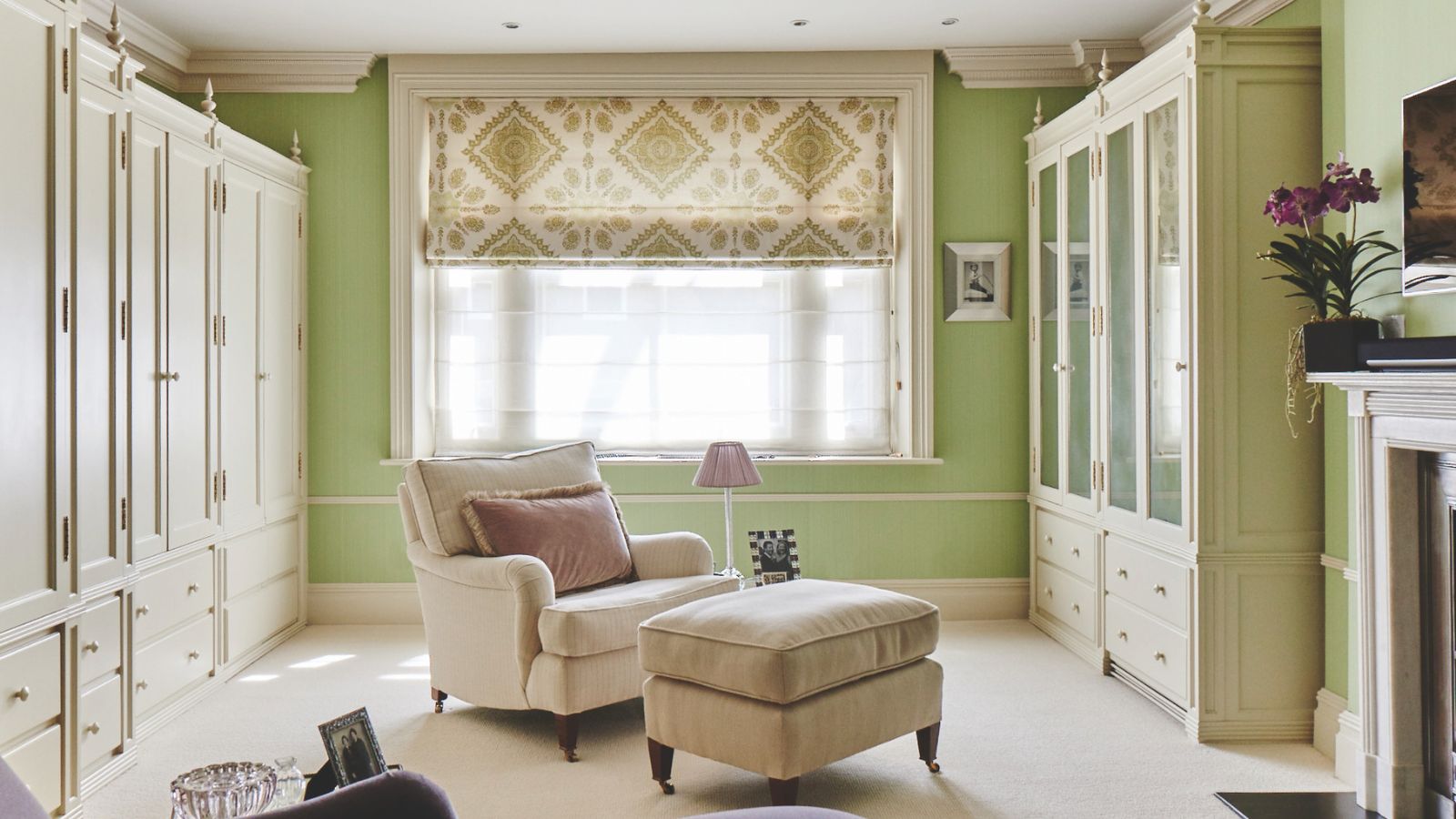 7 expert-approved painting hacks to minimize clean up – to make an already exhausting task easier
7 expert-approved painting hacks to minimize clean up – to make an already exhausting task easierAvoid a backbreaking clean-up after your next painting project with advice from the professionals
By Chiana Dickson
-
 Gwyneth Paltrow's quiet luxury kitchen is so beautiful, we almost overlooked her ultra-smart cabinets – they make the use of 'every inch' of storage space
Gwyneth Paltrow's quiet luxury kitchen is so beautiful, we almost overlooked her ultra-smart cabinets – they make the use of 'every inch' of storage spaceThe Goop founder makes use of dead space in her kitchen with customized cabinetry that reaches to the ceiling, providing ample storage
By Hannah Ziegler